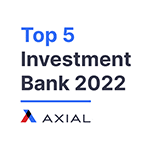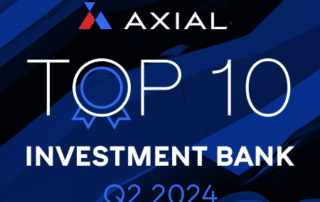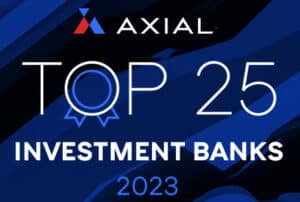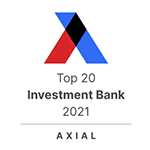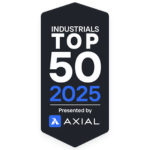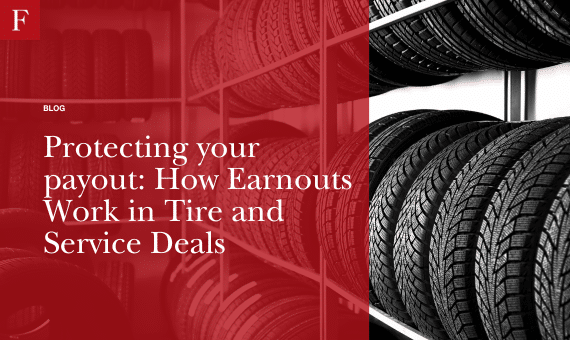
Protecting Your Payout: How Earnouts Work in Tire and Service Deals
When selling your automotive tire or service business, you likely have a number in mind for what it’s worth. The market, however, often has its own opinion. If you and a buyer can’t agree on a valuation, the deal might stall—or fall apart entirely.
Private equity (PE) buyers frequently propose earnouts to bridge this valuation gap. If you’re considering selling, understanding earnouts—how they function, why they’re used, and how to negotiate them—can help you secure the best possible payout while protecting your interests. Here’s what you need to know.
What Is an Earnout—and Why Might It Come Up?
An earnout is a portion of the sale price paid later, based on your business’s future performance or specific milestones. For instance, if your tire shop or service center posted an exceptional year—say, $5M in EBITDA compared to a $3M average—buyers may hesitate to pay full value for that high point unless they’re confident it’s repeatable. Was it a one-time surge, or can you sustain that growth?
To address this, buyers might offer a base price reflecting your “typical” performance and tie the rest to an earnout, covering the potential upside. They might also use earnouts to hedge against risks, like losing a major fleet contract or a key technician after the sale.
Buyers favor earnouts because they shift risk to you—if the business underperforms, they pay less. As a seller, you can view an earnout as a chance to prove your business’s value, but only if you negotiate terms that position you for success.
When Should You Agree to an Earnout?
Ideally, avoid earnouts altogether. But if there’s a gap between your valuation and the buyer’s upfront offer, an earnout can make sense.
For example, if your financials have fluctuated due to tire supply chain issues or seasonal service spikes, but you’re confident last year’s numbers show your true potential, an earnout can bridge that divide. Similarly, if you have a loyal customer base you’re sure will stay post-sale, you might feel comfortable tying part of the price to their retention.
Be prepared for buyers to zero in on uncertainties—customer loyalty, key staff retention, or operational hiccups. If you plan to exit fully, an earnout might hinge on a smooth transition. If you’re staying on, consider negotiating an equity stake instead, assuming the buyer’s structure allows it.
Shaping the Earnout to Work for You
A strong earnout starts with a fair base price—the foundation of your deal. Let’s say your business’s average EBITDA is $5M. The buyer should pay for that at closing (e.g., $30M at a 6x multiple). If last year’s EBITDA hit $6.5M, the earnout should cover that extra $1.5M (another $9M at 6x). This split ensures you’re paid for your proven value while earning more for exceeding expectations.
Key questions to ask when evaluating an earnout:
- Amount: How much of the total price is tied to the earnout?
- Metrics: What triggers the payout—revenue, EBITDA, or another benchmark?
- Thresholds: Are the performance targets realistic and achievable?
- Timing: When will performance be measured, and when will you be paid? Shorter periods lower your risk.
Protect Your Earnout
Your top priority? Ensuring the buyer can’t undermine your earnout. A common seller concern is losing control—post-sale, the buyer runs the business, and their decisions could impact your payout. You need safeguards to prevent them from cutting corners, like reducing marketing or laying off critical staff, which could jeopardize performance.
At a minimum, negotiate an operating covenant requiring the buyer to maintain the business in good faith and avoid actions that could harm the earnout. Buyers often resist this clause, but it’s worth pushing for.
Other protections to consider:
- Your Role: If you’re staying on to help with the transition, what happens if they let you go? Secure “for cause” or “good reason” clauses to protect your earnout.
- Breach Penalties: If the buyer violates a covenant, negotiate for a full earnout payout—or at least a calculation of what you would have earned.
- Indemnification: Buyers might try to deduct unrelated claims from your earnout. Limit their ability to do so.
- Metrics Clarity: Specify how the earnout is calculated. Is it calculated on EBITDA or Revenue? If it’s based on EBITDA, whose formula applies—yours or the buyer’s, which might include new overhead costs?
- Terms: Define performance targets clearly. Consider catch-up provisions or sliding scales to make the earnout fairer over time.
Work with advisors to lock in these details upfront. Ambiguity can lead to costly disputes later.
A Few Watchouts
Earnouts can be complex. While they may offer tax advantages, they also carry risks—vague terms or buyer mismanagement can erode your payout. I’ve seen sellers lose millions due to poorly defined agreements or buyers steering the business to avoid earnout triggers.
Partner with an advisor and attorney experienced in private equity deals. They’ll help you navigate the nuances and spot red flags before you sign. Done right, an earnout can reward you for your business’s true potential. Done poorly, it can cost you dearly.






